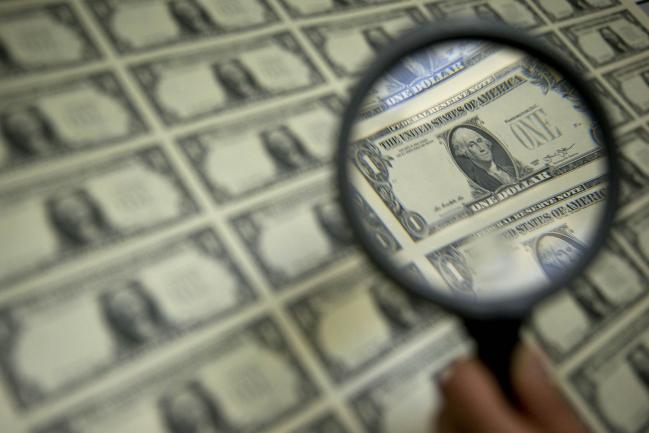(Bloomberg) -- A growing chorus of Wall Street foreign-exchange analysts is writing about the risk that U.S. President Donald Trump may move beyond words in his quest for a weaker dollar.
From ING to Canadian Imperial Bank of Commerce, more analysts in recent weeks have been openly contemplating the wild-card notion that the administration could intervene to cheapen the dollar. The research comes as Trump has intensified criticism of both the Federal Reserve and other countries’ currency practices. The U.S. leader tweeted last week that Europe and China are playing a “big currency manipulation game,” and called on the U.S. to “MATCH, or continue being the dummies.”
The U.S. last intervened in FX markets in 2011, when it stepped in along with international peers after the yen soared in the wake of that year’s devastating earthquake in Japan. While that effort boosted the dollar, ING says the American administration may move to do the opposite -- and weaken the greenback should the European Central Bank pursue further monetary stimulus. The U.S. hasn’t taken that step since 2000.
Fed Link
“Could frustration with the Fed prompt the President to take matters in his own hands and weaken the dollar?” ING’s Chris Turner and Francesco Pesole wrote in a note Monday. Though the U.S. last month reaffirmed a Group-of-20 commitment to refrain from competitive devaluation, “the lure of a weaker dollar to support the U.S. economy into 2020 may be too great,” the strategists wrote.
The market has yet to put any stock in the notion of U.S. intervention: Global currency volatility is at a five-year low, and the Bloomberg dollar index is barely changed this year. But a Fed trade-weighted measure of the dollar is not far below the strongest since 2002, underscoring the headwind American exports face overseas.
Below is what some banks are saying about the prospect that the U.S. could act to weaken the dollar:
ECB Trigger
- “So far, the White House has exerted indirect pressure on the dollar via the need for Fed easing,” wrote ING’s Turner and Pesole. “If the dollar doesn’t start to fall later in the year, we suspect pressure will grow for the U.S. Treasury to take more direct action on the dollar.”
- “Were the ECB to cut rates in late July or enact a fresh round of quantitative easing in September – such that EUR/USD comes under fresh pressure – Washington could potentially respond.”
- “The wild-card of FX intervention is another reason why we prefer the dollar to be topping out this summer and retain year-end forecasts for EUR/USD and USD/JPY at 1.15 and 103 respectively.”
‘Tinfoil-Hat’ Scenario
- “Trump’s repeated comments on the Fed and dollar’s misalignment with the CNY and the EUR mean we can’t rely on the old paradigm that the Treasury won’t intervene and undermine the ‘strong dollar’ policy at some point,” said CIBC’s Bipan Rai, North American head of foreign-exchange strategy
- Unilateral FX intervention by the U.S. would likely spur only a “temporary” dollar sell-off, given that the average daily dollar flow dwarfs the reserves available in the Treasury Department’s Exchange Stabilization Fund, he wrote.
- While not CIBC’s base case, a “tinfoil hat” scenario could see the Treasury pressure the Fed to liquidate its balance sheet to provide more dollars for intervention purposes
- “This could create a lasting downward effect on USD valuation, given the incredible size of the Fed’s balance sheet.”
- While multi-lateral intervention in the style of the 1985 Plaza Accord is the most likely method to achieve lasting greenback weakness, “Trump’s antagonism on the trade front” has done him no favors, Rai wrote
- China, Japan, Switzerland, Russia, India, South Korea, Brazil and the euro zone “all have reasons not to cooperate,” according to Rai
‘Highly Unusual’
- “Although it would be highly unusual for a U.S. government to attempt further measures to weaken the USD, it is not beyond the realms of possibility that the Trump administration will try,” Rabobank’s Jane Foley, head of currency strategy, wrote in a July 5 note.
- “While the Fed now has more room than many other central banks to cut rates going into the downturn, the dominance of the U.S. in the global payments system points to an ongoing underlying demand for USDs which could temper the pace of any decline.”
- “Since it is the Treasury, rather than the Federal Reserve that is in charge of USD policy in the U.S., it is technically possible that the U.S. government could order the Fed to intervene in the market to sell USDs in the market.”
Administration’s Options
- More quantitative easing by developed-market central banks could lead to “a further metastasis of trade wars into currency wars,” Citigroup (NYSE:C) economists Cesar Rojas and Catherine Mann wrote in a July 2 note
- The Trump administration’s options for curbing dollar strength include a stabilizing mechanism and “countervailing” intervention against currency manipulators
- The Treasury could use the Exchange Stabilization Fund and swap acquired currencies for dollars with the Fed
